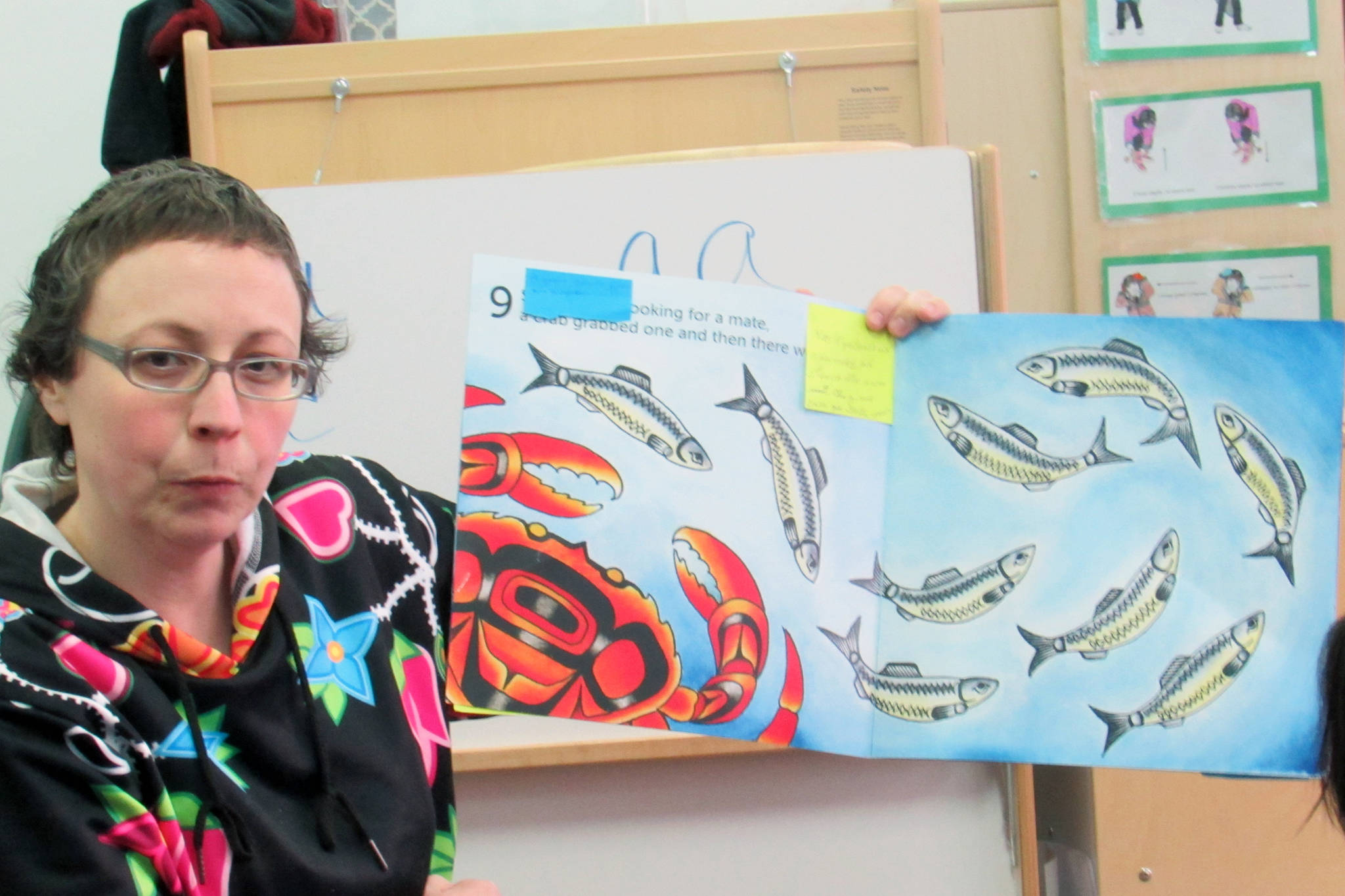The familiar melody of “Frère Jacques” filled a classroom inside the Tlingit & Haida Vocational Training & Resource Center with a vibrant noise that matched the bright primary colors of the many of the objects in the room.
The version of the inescapable tune sung by a handful of children and educators Monday night wasn’t in the typical French — it was in the Tlingit language Lingít.
The song was part of a family night for the soon-to-open Lingít-immersion preschool, Haa Yoo X’atángi Kúdi, which means Our Language Nest.
“I think it’s going to be great,” said Kaaxh Ts’éen Herb Sheakley, who attended the event with his daughters, Kátíx’di Raven Sheakley, 7, and Kax du.óo Mayzie, 5, and his wife, Emily.
Kax Du.óo Mayzie will be one of the up-to 13 children between the ages of 3 and 5 participating in the program when it opens Tuesday, April 30.
The program is meant to be a step in revitalizing and perpetuating an endangered language.
[Juneau’s first Tlingit-langauge pre-school readies to open]
The Endangered Languages Project estimates there are about 200 fluent speakers of Lingít worldwide. The Alaska Native Language Center similarly puts that figure at 175 speakers.
The state Legislature and former-Gov. Bill Walker recognized a linguistic emergency for Alaska Native languages last year. Alaska Native languages are endangered because of past colonial efforts to stop Alaska Natives from speaking their languages, including boarding schools, which persisted into the 20th century.
Functionally, Haa Yoo X’atángi Kúdi will work like most other pre-kindergarten programs.
There will be educational activities, snacks, stories, naps or quiet time, but inside the classroom, only Lingít will be spoken.
Mary Daaljíni Folletti, lead instructor and administrator for the language nest, said to start the child care program will operate noon-4 p.m. Tuesday to Friday, but it may expand in scope over time.
“For now, we’re trying to start small,” she said.
Folletti will have the assistance of two other staff members, Nae Brown and Mallory Story.
The program has been a longtime goal of the Central Council of Tlingit and Haida Indian Tribes of Alaska, and it was helped along by a three-year, $1 million federal grant from the Administration of Native Americans.
Folletti said it is hoped the program will be a first step toward Tlingit-language options for elementary school, middle school and even high school.
Until that happens, Folletti said the Tlingit Culture, Language and Literacy (TCLL) program based in Harborview Elementary School helps fill a gap.
TCLL is a place-and-culture-based school within the school that is open to all kindergarten through fifth-grade students consisting of three multi-age classrooms. It incorporates Tlingit language, culture and elders. Funding for the program is provided through Sealaska Heritage Institute with support from the U.S. Department of Education’s Alaska Native Education Program.
[PHOTOS: Alaska Native language summit]
“I like to call it an enriched curriculum,” said program coordinator Frank Henry Kaash Katasse.
Harborview principal Tom McKenna said he’s glad his school houses TCLL and even students who are not enrolled in it pick up cultural insights from friends.
“It grounds us in the roots of where we live and whose land we live on and the cultural foundation of Juneau,” McKenna said.
While the language nest and TCLL are not officially affiliated, Folletti and Katasse have discussed ways the two may be related. The programs share goals, and parents involved in one program are likely to be interested in the other.
Folletti plans to to enroll her daughter in the TCLL program, and Katasse said he intends for his children to be part of Haa Yoo X’atángi Kúdi.
The TCLL had an open house Monday morning to allow interested parents to visit classrooms and find out more about the program ahead of Friday’s application deadline.
The open house began with the story of Raven and the tides told by David Kingeistí Katzeek, a Tlingit elder who helps with TCLL.
[Langauge takes center stage at banquet]
In addition to teachers, TCLL classrooms have a elder in the classroom for four hours each day, Katasse said, and that adds perspective and a living Tlingit-language dictionary to the class.
Katasse said the story told Monday serves as a place-based way to introduce the concept of tides, which will be the focus of lessons for the next couple of weeks.
The story, Katzeek said, also introduces a culturally important lesson about the potentially devastating impact of hoarding resources.
Katzeek, who has been part of the TCLL program for more than a decade, closed his story by speaking about the important work being done to keep the Tlingit language alive.
“What you’re doing is a miracle,” Katzeek said.
• Contact arts and culture reporter Ben Hohenstatt at (907)523-2243 or bhohenstatt@juneauempire.com. Follow him on Twitter at @BenHohenstatt.

